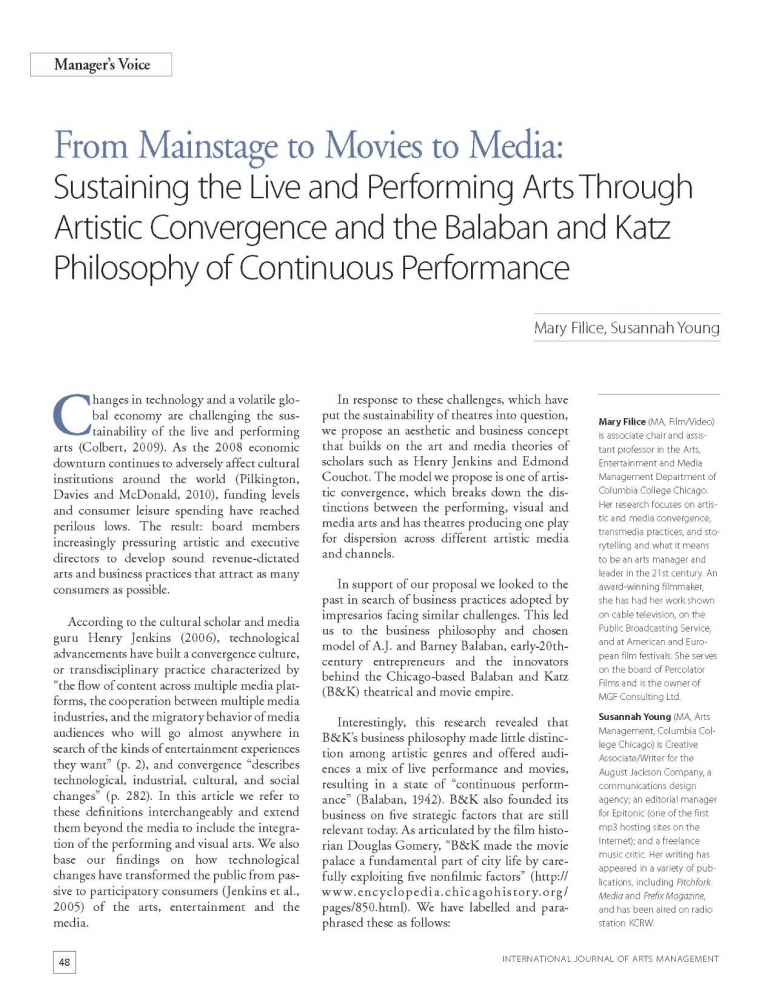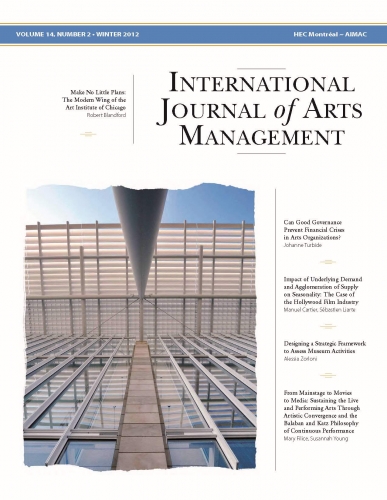From Mainstage to Movies to Media: Sustaining the Live and Performing Arts Through Artistic Convergence and the Balaban and Katz Philosophy of Continuous Performance
Product: Article
$21.00 CA
Mary Filice, Susannah Young
Mary Filice (MA, Film/Video) is associate chair and assistant professor in the Arts, Entertainment and Media Management Department of Columbia College Chicago. Her research focuses on artistic and media convergence, transmedia practices, and storytelling and what it means to be an arts manager and leader in the 21st century. An award-winning filmmaker, she has had her work shown on cable television, on the Public Broadcasting Service, and at American and European film festivals. She serves on the board of Percolator Films and is the owner of MGF Consulting Ltd.
Susannah Young (MA, Arts Management, Columbia College Chicago) is Creative Associate/Writer for the August Jackson Company, a communications design agency; an editorial manager for Epitonic (one of the first mp3 hosting sites on the Internet); and a freelance music critic. Her writing has appeared in a variety of publications, including Pitchfork Media and Prefix Magazine, and has been aired on radio station KCRW.
ABSTRACT
Worldwide economic uncertainty has put the sustainability of the live and performing arts into question. Furthermore, due to technological changes, theatres must cope with audiences that access nearly all forms of entertainment using a single device, switch gears rapidly, and expect entertainment venues to share and achieve their aims. In response to these challenges, the authors offer a new business model and aesthetic of artistic convergence. In this concept, the distinctions between the performing, visual and media arts are broken down and theatres produce one play for distribution across different artistic mediums and channels. To support their proposal, the authors look to the past and demonstrate how the business philosophy and model employed by the early-20th-century movie and theatrical innovators Balaban and Katz are relevant and applicable today.
KEYWORDS
Artistic convergence, business model, media, movie palace, theatre, transmedia
RÉSUMÉ
La volatilité de l’économie mondiale remet en question la viabilité des arts vivants et des arts de la scène. De plus, en raison des changements technologiques, les théâtres doivent faire face à des publics qui accèdent à pratiquement toutes les formes de divertissement au moyen d’un seul appareil, modifient leur choix rapidement, et s’attendent à ce que les salles de spectacles partagent et atteignent leurs propres objectifs. En réaction à ces défis, les auteures présentent un nouveau modèle d’affaires et une esthétique de convergence artistique. Selon ce concept, les distinctions entre les arts de la scène, les arts visuels et les arts médiatiques sont éliminées et les théâtres produisent une pièce qu’ils présentent par différents médias artistiques. Pour appuyer leur proposition, elles se tournent vers le passé pour montrer comment la philosophie et le modèle d’affaires des innovateurs Balaban and Katz, du début du XXe, sont pertinents et applicables de nos jours.
MOTS CLÉS
Convergence artistique, modèle d’affaires, médias, salles de cinéma opulentes, théâtre, transmédias
RESUMEN
La incertidumbre económica mundial ha hecho que se ponga en duda la viabilidad de las artes vivas y escénicas. Además, con las nuevas tecnologías, los teatros se ven ante la tarea de adaptarse a públicos que tienen acceso a casi todo tipo de espectáculos usando un solo aparato, pasando de un espectáculo a otro con facilidad y con la expectativa que los espacios escénicos compartan y alcancen sus objetivos. Frente a tales desafíos, los autores del artículo ofrecen un nuevo modelo empresarial y estético, la convergencia artística, un concepto que derrumba las barreras entre las artes escénicas, visuales y mediales y que permite a los teatros producir une obra de teatro que se puede distribuir a través de diferentes medios y canales artísticos. Para sustentar sus propósitos, los autores estudian el pasado y demuestran cómo la filosofía empresarial y el modelo que los innovadores en el ámbito del teatro y del cine Balaban y Katz utilizaron a principios del siglo veinte sigue siendo relevante y aplicable hoy en día.
PALABRAS CLAVE
Convergencia artística, modelo empresarial, medios de comunicación, palacio de cine, teatro, transmedia

